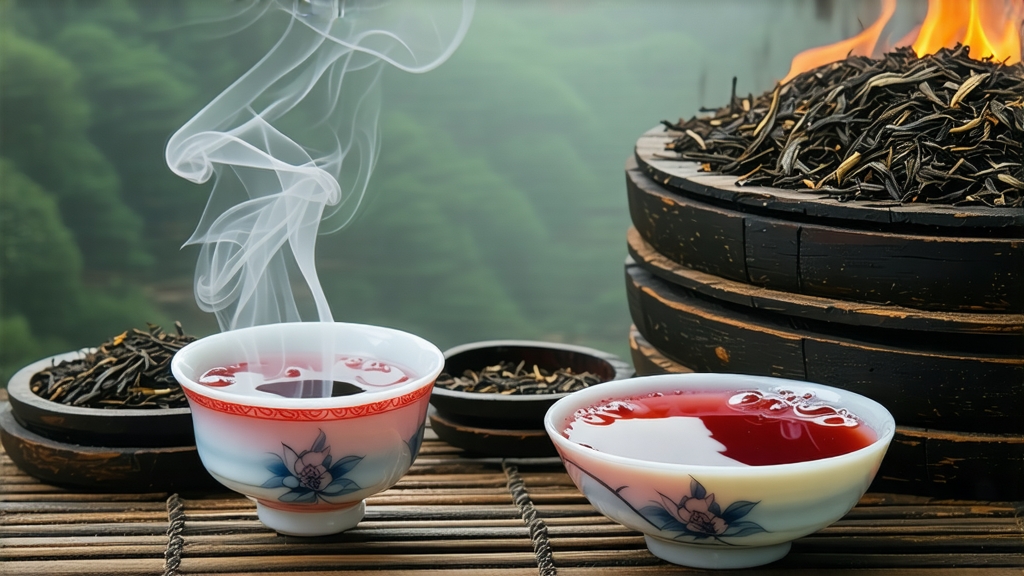
Long before Assam, Ceylon or Darjeeling entered the lexicon of tea drinkers, the cliffs of northern Fujian echoed with the crackle of pine torches and the rustle of freshly picked leaves. There, in the Wuyi Mountains, a small village called Tongmu gave birth to what would become the world’s first fully oxidised tea—Lapsang Souchong. International audiences often meet it as “that smoky tea’, yet behind the fragrant veil of ember and resin lies a story of maritime empires, imperial favour and meticulous craft that has remained unchanged for almost four centuries.
History: From Mountain Hamlet to Global Sensation
Local legend claims the smoke-drying technique was born of military urgency. Qing troops, so the tale goes, quartered themselves in tea workshops during the 1640s, forcing farmers to speed-dry their leaf over open fires so that the crop could be rushed to market. Whatever the truth, Dutch traders tasted the result in Xiamen port in 1646, labelled it “bohea” (a corruption of “Wuyi”), and shipped it to Amsterdam where it fetched higher prices than green teas. By the late 1600s London coffeehouses were advertising “Souchon – the China drink that promotes lasting vigour”, and the British East India Company listed it among its first bulk imports. The tea travelled so well—its smoke acting as a natural preservative—that it became the template for every black tea that followed, giving the English language the very word “black” to distinguish fully oxidised leaf from the greener styles already known in Europe.
Terroir: Why Only Tongmu Can Birth Authenticity
Authentic Lapsang Souchong is protected by both Chinese National Geographical Indication and UNESCO’s World Heritage buffer zone around the Wuyi Biosphere Reserve. The canyon village of Tongmu sits at 27° N latitude, hemmed by 1,200-metre granite cliffs that trap humid subtropical air. Morning fog diffuses sunlight into a soft, silver glow, slowing photosynthesis and concentrating amino acids, especially L-theanine. The soil is a coarse, well-drained laterite rich in quartz and manganese, forcing tea roots to struggle and thereby deepening flavour. Six indigenous cultivars—Xiao Ye Zhong, Zai Pei, Wu Jia, Ai Jiao, Da Bai Ye and the prized Mi Xiang—thrive here, but only the two smallest-leafed clones are picked for true Souchong, the term “souchong” itself referring to the fourth or fifth leaf on the stem, larger and tougher than the bud but still tender enough to roll.
Plucking Calendar: One Dawn, Two Leaves, Three Rules
The harvest window opens for barely ten days around Grain Rain (20 April) when overnight temperatures rise above 15 °C but daytime heat has not yet climbed past 25 °C. Pickers climb 70-degree bamboo ladders at 4:30 a.m. while dew still pearls the leaf backs; they snap the stem with thumbnail and forefinger, never shears, to avoid bruising. Three strictures govern the pluck: no insect-bitten leaf, no purple variegation, no surface moisture. A skilled woman can gather just eight kilograms of fresh leaf by noon—enough, after withering and firing, to yield a single kilo of finished tea.
Craft: The Eight Stages of Smoke and Silence
- Outdoor Withering: Leaves are laid on slatted bamboo racks set into stone courtyards. For the first 90 minutes they bask in the mountain breeze, losing roughly 10 % moisture and developing a light grassy aroma.
- Indoor Withering: Racks are moved into the upper loft of the workshop where pine embers smoulder in corner pits. Temperature hovers at 28 °C, humidity at 65 %. Over four hours the leaf softens, edges redden, and a faint resinous note appears.
- Rolling: A 55-cm diameter bamboo-ribbed roller, turned by hand for 45 minutes, ruptures cell walls without shredding the leaf. Sap oxidises on contact with air, shifting colour from jade to copper.
- Oxidation: The leaf is piled 8 cm deep in rattan trays and slid into a humidified cedar closet. For three hours enzymes convert catechins into theaflavins